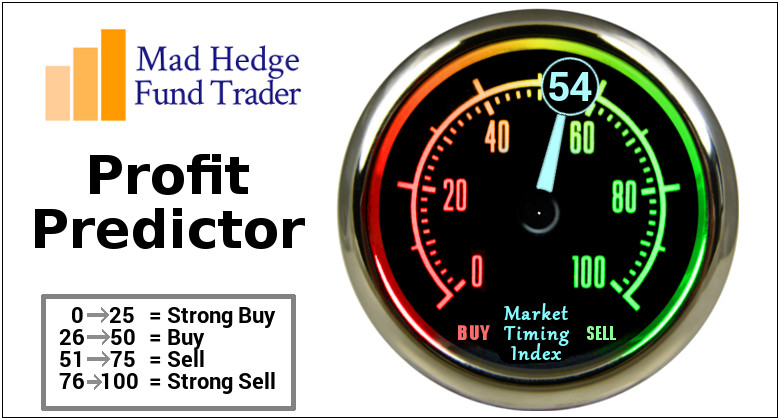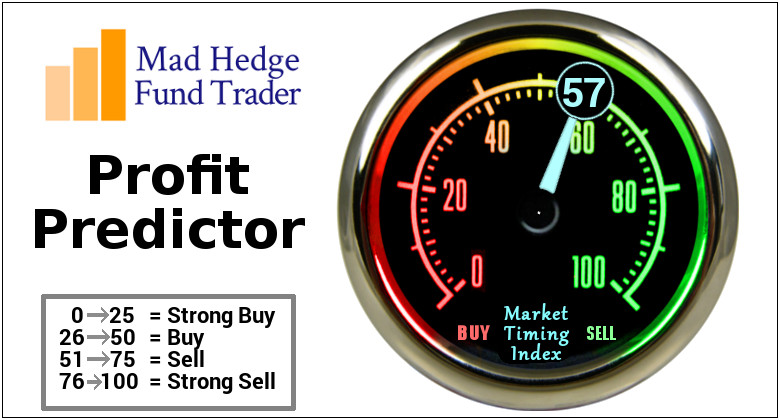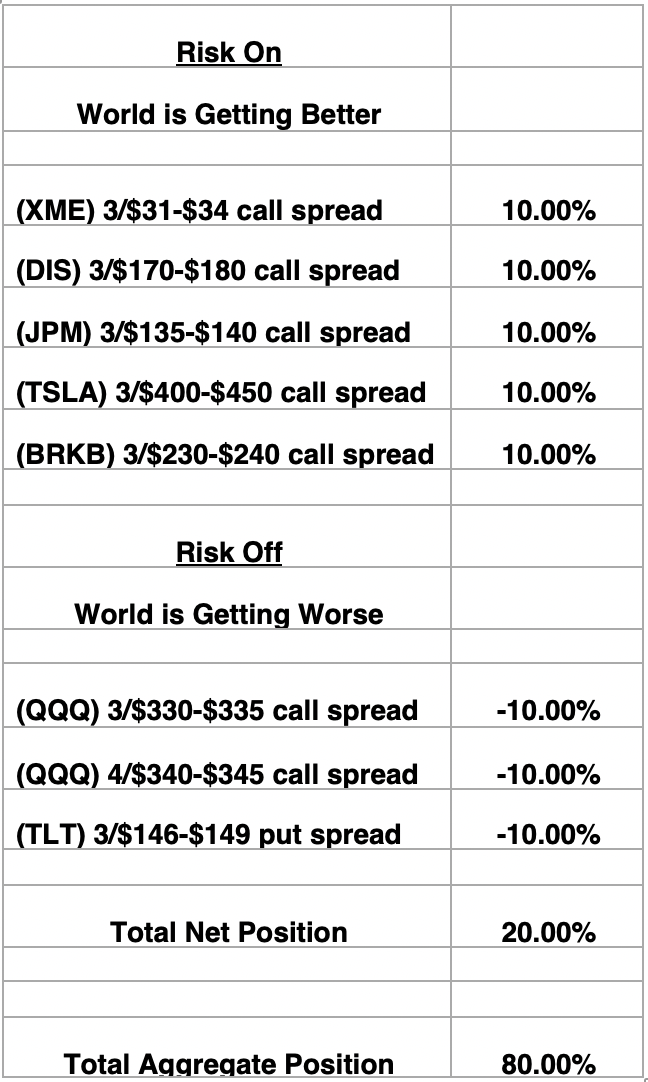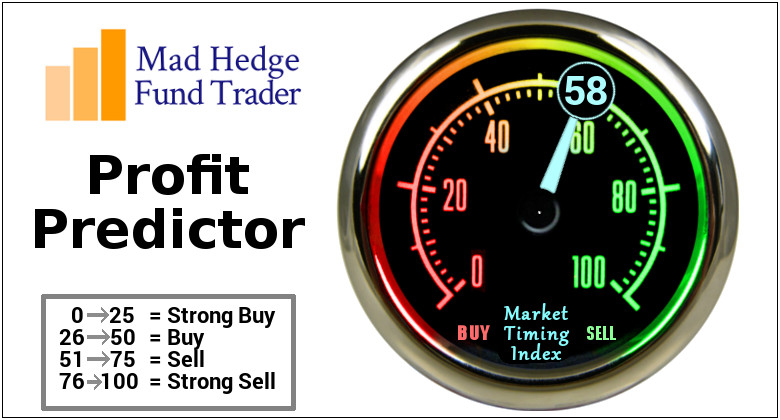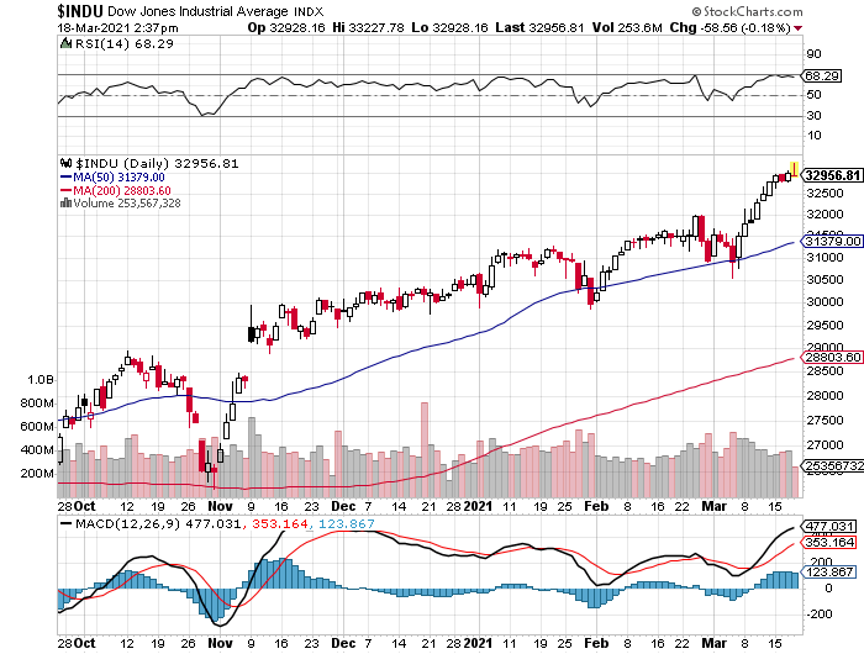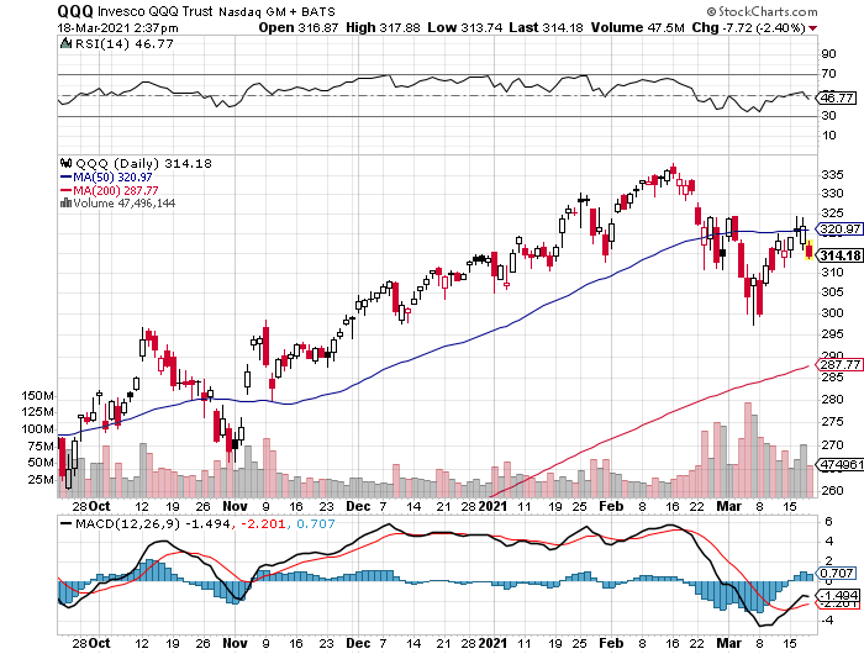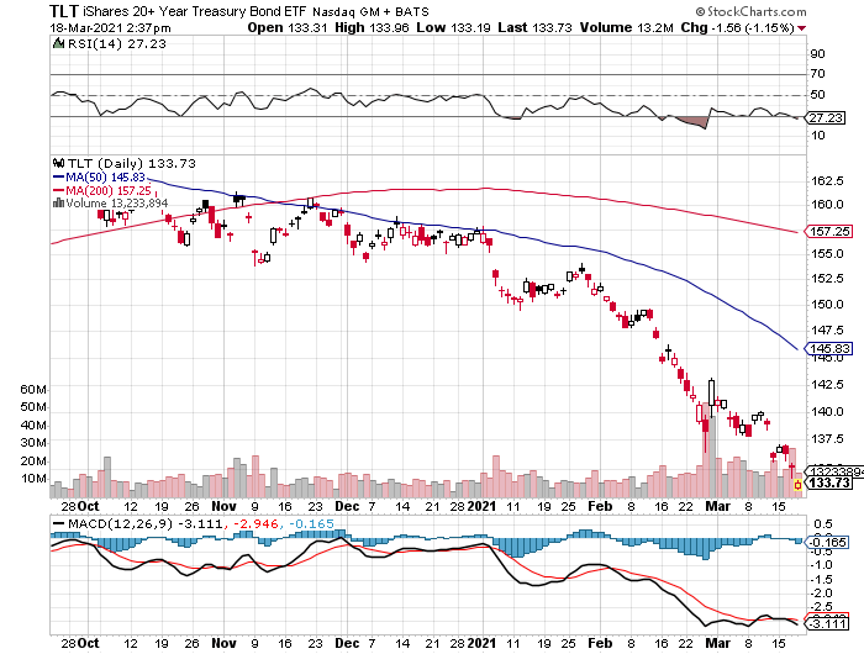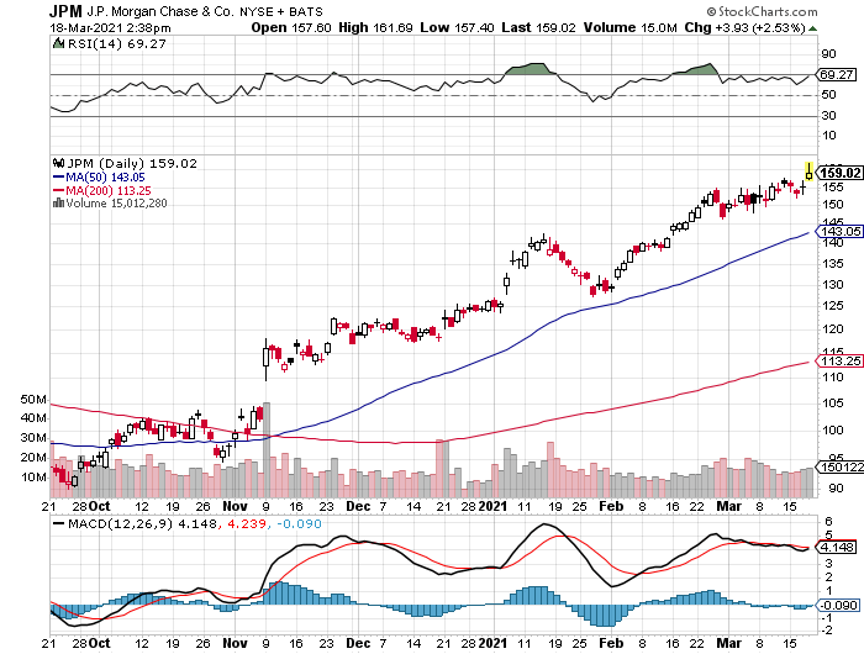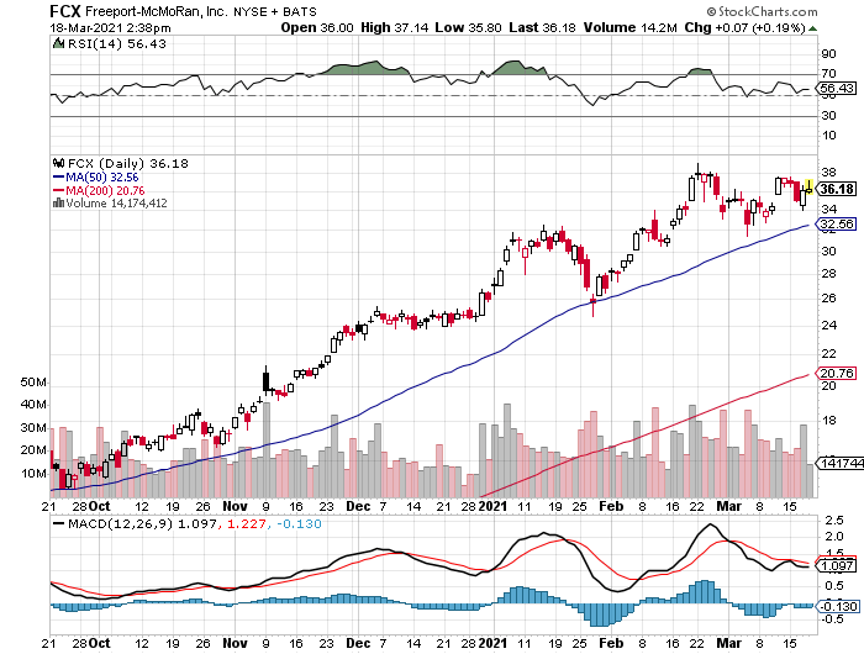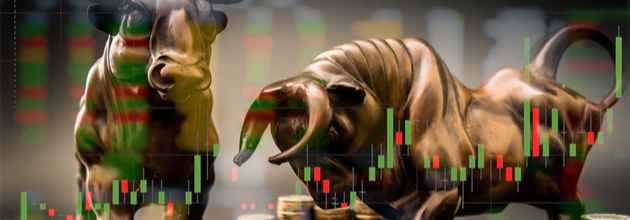|
Top News
Shutterstock The S&P 500 and Dow Jones averages rebounded from early losses to finish lower Friday while the Nasdaq ended higher as investors bought the dip in tech shares. Stocks gained strength after the Wall Street Journal published an op-ed from Fed Chairman Jerome Powell reiterating the central bank's commitment to provide aid to the economy "for as long as it takes." Bank stocks weighed on the Dow in reaction to the Fed's decision not to extend a rule exempting U.S. Treasurys from the supplementary leverage ratio. The 10-year Treasury yield breached the 1.75% level for the first time in 14 months and has now surged about 80 basis points this year. For the week, the Dow and S&P fell 0.5% and 0.8% respectively, snapping two-week winning streaks, while the Nasdaq also lost 0.8% to cap its fourth negative week in five



| |
|---|
On The Move
The Fed's optimistic, but are investors? Stocks swung wildly following the FOMC's highly anticipated meeting on Wednesday as the yield curve pulled back, steepened, then pulled back once more. The central bank sharply upgraded its 2021 GDP growth forecast to 6.5%, the largest annual output since 1984, and also said it expected unemployment to drop. Fed Chair Jerome Powell added that inflation was forecast to reach 2.4% this year, but called it a temporary surge, while the biggest news was a pledge not to raise interest rates until 2024.
Why the volatility? Some attributed the movement to the differing reactions of bond market players. At first, they focused on the Fed's "no hikes through 2023," but then absorbed its plan to let inflation run hot. In reality, the volatility may just be a broader symptom of Treasury market unpredictability. Investors don't like uncertainty and markets definitely don't like uncertainty, and until we reach a broader consensus over how the inflation equation will play out, we could see unstable moves in every direction.
The bulls: "It's a mistake to dump growth stocks out of fear of rising inflation," said Mad Money's Jim Cramer. "The Fed's basically saying, 'Party on, industrials' which causes the hedge funds to buy them hand over fist. Problem is, if they want to buy the banks or the smokestack stocks, they need to sell something else like the high-growth tech stocks that they always dump, and that's called the hedge fund playbook."
The bears: "If the yield on the 10-year Treasury note climbs to 2.0%, that could be enough to tip the risk market scales and lead to a 10% correction in the S&P 500. If the 10-year climbs to 2.5%, bonds may even start becoming more attractive instead of stocks," according to the latest BofA fund manager survey. "Higher growth and higher inflation is now the consensus." ( 34 comments)



| |
|---|
Sponsored By Seeking Alpha

Get 5 Must-Read articles, straight to your inbox. “Power to Investors” is Seeking Alpha’s standard since 2004. We bring you the most popular and thought-provoking stories and in-depth coverage BY and FOR investors. Subscribe - its free » | |
|---|
Economy
Many entertainment venues that were shut down more than a year are starting to show signs of life as companies continue to make reopening announcements. The theme can be clearly seen in financial markets, where the cyclical trade has been on fire. The Dow Jones Industrial Average (NYSEARCA: DIA) closed at a record 33,015.37 on Wednesday, just five trading days after clearing the 32,000 milestone (get out your "Dow 33K" caps).
The latest? Disneyland ( DIS) in Anaheim, California will reopen April 30, with the parks operating at around 15% capacity to start. "I think as people become vaccinated, they become a little bit more confident in the fact that they can travel, and, you know, stay Covid-free," CEO Bob Chapek told CNBC. "Consumers trust Disney to do the right thing, and we've certainly proven that we can [open] responsibly, whether it’s temperature checks, masks, social distancing, [or] improved hygiene around the parks."
That's not all. AMC Entertainment (NYSE: AMC) anticipates that 98% of its U.S. circuit will be reopen this weekend following the theater chain's toughest year in history. AMC repeatedly came close to filing for Chapter 11 in 2020 and saw most new films delayed because of the coronavirus pandemic. Americans are also taking to the air again as COVID-19 restrictions ease across many parts of the U.S. According to the TSA, about 2.5M passengers went through airport checkpoints nationwide last weekend, sending airline stocks higher.
Outlook: Corporations are not the only ones experiencing a windfall from a broader vaccine rollout and declining COVID caseloads. More than half of U.S. small businesses are fully reopened as many local restrictions were lifted, according to a report from Kabbage, a fintech owned by American Express ( AXP). Will pre-pandemic commercial occupancy rates return? 33% of surveyed businesses said they would expand digital operations to supplement or replace in-person operations, while only 15% would scale back digital operations to pre-pandemic levels. (9 comments)



| |
|---|
Outlook
Are value stocks turning into their tech-based momentum rivals? Bernstein thinks so, and believes a rotational shift could accelerate in coming weeks to give the sector a fresh boost.
Quote: "There is a significant overlap emerging between deep value stocks and momentum stocks - there are a number of autos, banks, materials, and energy stocks which are screening as both value and momentum," wrote strategists led by Sarah McCarthy. "This is the holy grail of quant and value investing."
To back up the outlook, Bernstein points to market movement around the time of the $1.9T coronavirus stimulus package, which sent investors rushing to buy stocks exposed to an accelerating economy and rising inflation. That resulted in a portfolio changeover to financials, energy and industrials and away from tech, which had dominated momentum investing for much of the last decade.
Go deeper: The catalyst for this value rotation "is very different to any period in history," Bernstein continued. "It is being driven by the re-opening trade, and improving macro outlook, and is directly linked to continuously increasing nominal yields, a steepening yield curve and increasing inflation expectations. We are in a very different policy environment and possibly are at the start of a much bigger change in the inflation regime. We are tactically long Value and think there is further to go."



| |
|---|
Healthcare
Medical experts in the U.S. are trying to calm fears that COVID-19 vaccines may be unsafe after several European countries suspended AstraZeneca's (NASDAQ: AZN) jab amid reports of blood clots among some recipients. The European Medicines Agency (EMA), which evaluates drug safety for the EU, has maintained that the benefits of the shot when it comes to preventing hospitalizations and deaths still "outweigh the risks of side effects." It confirmed the findings on Thursday, while the World Health Organization subsequently agreed with the verdict, urging countries to continue using AstraZeneca's vaccines.
Bigger picture: It took some time, as well as data, to establish whether the inoculations were causing the reported blood clots. Medical events in the older population occur every day, even without vaccines, and it is hard to determine whether vaccines can accelerate, precipitate or cause these events. Of the more than 17M people in the EU and the U.K. who have received a dose of the Oxford-AstraZeneca vaccine, fewer than 40 cases of blood clots had been reported as of last week.
What's clear is that AstraZeneca has a public relations mess on its hands. "There's now been a pall over this vaccine," said Dr. William Schaffner, an epidemiologist and professor of preventive medicine at Vanderbilt University, prior to EMA's decision. "I think if the vaccine is cleared - not guilty - there will have to be a substantial PR effort made in Europe and around the world in order to restore confidence in this vaccine.
Go deeper: When Pfizer (NYSE: PFE) and Moderna (NASDAQ: MRNA) initially distributed their vaccines in December, there were reports of severe allergic reactions, or anaphylaxis. However, those cases appear to be rare, according to Dr. Anthony Fauci, with the U.S. having administered 113M doses to date. "Thus far, and you have to keep following these things very carefully, there are no safety signals that turn out to be red flags," he said regarding the currently deployed vaccines in the U.S. While the AstraZeneca vaccine hasn't been cleared for American use, there will likely be enough safety and efficacy data to grant the vaccine emergency use authorization in April. ( 17 comments)



| |
|---|
Cryptocurrency
It was only a week ago that Christie's sold a Beeple JPEG collage to an investor who paid $69M in cryptocurrency, but it may have marked the beginning of the digital art revolution. Rival auction house Sotheby's is joining the non-fungible token craze through a collaboration with digital artist Pak. It's also considering an option to eventually allow collectors to pay, and potentially get paid, using digital currencies.
Quote: "We've been following the NFT space for some time," Sotheby's CEO Charles Stewart declared. "In the last 12-18 months there has been an acceleration in everything digital. In the art world, there's been a pivot towards digital in almost everything, perhaps, except the art. Now we're getting there with the art as well."
Skeptics note the ascent of NFTs has coincided with a massive crypto rally and have dismissed them as a fad whose values will fall over time. Others, like ARK Invest, feel NFTs will "unlock more value for content creators than any platform in history."
Outlook: A move to accept digital currencies for physical works or NFTs could potentially fuel sales if it prompts crypto millionaires to start bidding on high-end art. The demographic could also help prop up the market, which leaned heavily on millennials to lift slumping sales last year and has struggled with fresh art auctions due to the coronavirus pandemic. ( 11 comments)



| |
|---|
Trending
Digital payments giant Stripe ( STRIP) raised $600M in new funding this week at a $95B valuation, making it the most valuable startup in the U.S. It's nearly triple the $36B valuation Stripe secured last April, when it raised another $600M from investors including Andreessen Horowitz and Sequoia Capital. Investors in this round include Allianz, Fidelity and Baillie Gifford, as well as the sovereign wealth fund of Ireland, which is the home country of Stripe founders John and Patrick Collison.
Backdrop: Stripe was founded in 2010 by the two Irish siblings (their net worth jumped to $11.4B each with the latest valuation). The company's software, which competes with ****** (NASDAQ: PYPL) and Square (NYSE: SQ), is used by businesses to accept online payments and has been a big beneficiary of the e-commerce boom accelerated by the coronavirus pandemic. Customers include Amazon ( AMZN), Instacart ( ICART), Salesforce ( CRM) and Lyft ( LYFT).
Stripe is "highly capital efficient" and didn't really need the money in spite of the fundraising, CFO Dhivya Suryadevara declared. "I view this as a bit more opportunistic," she said in an interview on Sunday. "It will just sit on the balance sheet," added Mike Moritz, partner at Sequoia and a Stripe board member, emphasizing that the money will be used as a "a rainy day fund." Some of the capital will also be invested in Stripe's European operations and its dual headquarters in Dublin.
Outlook: While Stripe isn't focusing on an initial public offering right now, both Suryadevara and Moritz said the company will continue to seek out acquisitions. In December, the company branched out to offer checking accounts to businesses through e-commerce providers, inking partnerships with banks including Goldman Sachs ( GS) and Citigroup ( C). ( 45 comments)



| |
|---|
U.S. Indices
Dow -0.5% to 32,628. S&P 500 -0.8% to 3,913. Nasdaq -0.8% to 13,215. Russell 2000 -2.8%to 2,288. CBOE Volatility Index +1.3% to 20.95.
S&P 500 Sectors
Consumer Staples +0.2%. Utilities -0.3%. Financials -1.7%. Telecom +0.5%. Healthcare +0.4%. Industrials -0.3%. Information Technology -1.4%. Materials -0.8%. Energy -7.7%. Consumer Discretionary -0.2%.
World Indices
London -0.8% to 6,709. France -0.8% to 5,998. Germany +0.8% to 14,621. Japan +0.3% to 29,792. China -1.4% to 3,405. Hong Kong +0.9% to 28,991. India -1.8% to 49,858.
Commodities and Bonds
Crude Oil WTI -6.3% to $61.46/bbl. Gold +1.4% to $1,743.9/oz. Natural Gas -2.1% to 2.546. Ten-Year Treasury Yield -1.3% to 131.23.
Forex and Cryptos
EUR/USD -0.4%. USD/JPY -0.11%. GBP/USD -0.34%. Bitcoin -3.9%. Litecoin -10.5%. Ethereum -4.8%. Ripple +2.9%.
Top Stock Gainers
Takung Art Co (NYSEMKT: TKAT) +626%. Oriental Culture Holding (NASDAQ: OCG) +171%. Upstart Holdings (NASDAQ: UPST) +116%. Jiayin Group (NASDAQ: JFIN) +91%. ZK International Group Co. (NASDAQ: ZKIN) +75%.
Top Stock Losers
Kaspien Holdings (NASDAQ: KSPN) -40%. Solid Biosciences (NASDAQ: SLDB) -39%. NuZee (NASDAQ: NUZE) -36%. Entera Bio (NASDAQ: ENTX) -34%. Translate Bio (NASDAQ: TBIO) -33%.
Where will the markets be headed next week? Current trends and ideas? Add your thoughts to the comments section. |
|---|
|
|---|
|
|---|
|
|

